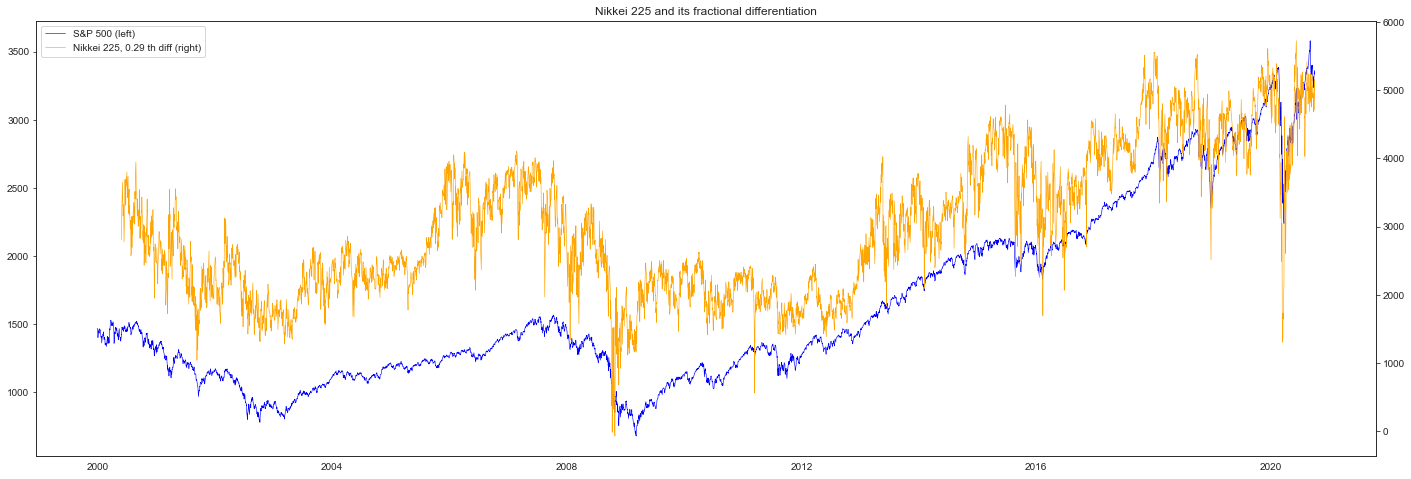如何使用#
[1]:
# !pip install matplotlib pandas pandas_datareader seaborn
# !pip install fracdiff
[2]:
import matplotlib.pyplot as plt
import pandas as pd
import pandas_datareader
import seaborn
seaborn.set_style("white")
[3]:
def fetch_yahoo(ticker):
"""Return pd.Series."""
return pandas_datareader.data.DataReader(
ticker, "yahoo", "2000-01-01", "2020-09-30"
)["Adj Close"]
分数阶微分#
[4]:
import numpy as np
from fracdiff import fdiff
[5]:
a = np.array([1, 2, 4, 7, 0])
[6]:
fdiff(a, n=0.5)
[6]:
array([ 1. , 1.5 , 2.875 , 4.6875 , -4.1640625])
[7]:
np.array_equal(fdiff(a, n=1), np.diff(a, n=1))
[7]:
True
[8]:
a = np.array([[1, 3, 6, 10], [0, 5, 6, 8]])
[9]:
fdiff(a, n=0.5, axis=0)
[9]:
array([[ 1. , 3. , 6. , 10. ],
[-0.5, 3.5, 3. , 3. ]])
[10]:
fdiff(a, n=0.5, axis=-1)
[10]:
array([[1. , 2.5 , 4.375 , 6.5625],
[0. , 5. , 3.5 , 4.375 ]])
通过分数阶微分进行预处理#
[11]:
from fracdiff import Fracdiff
spx = fetch_yahoo("^GSPC") # S&P 500
[12]:
X = spx.values.reshape(-1, 1)
f = Fracdiff(0.5, mode="valid", window=100)
X = f.fit_transform(X)
[13]:
diff = pd.DataFrame(X, index=spx.index[-X.size :], columns=["SPX 0.5th fracdiff"])
[14]:
fig, ax_s = plt.subplots(figsize=(24, 8))
ax_d = ax_s.twinx()
plot_s = ax_s.plot(spx, color="blue", linewidth=0.6, label="S&P 500 (left)")
plot_d = ax_d.plot(
diff,
color="orange",
linewidth=0.6,
label="S&P 500, 0.5th differentiation (right)",
)
plots = plot_s + plot_d
ax_s.legend(plots, [p.get_label() for p in plots], loc=0)
plt.title("S&P 500 and its fractional differentiation")
plt.show()

[15]:
from sklearn.linear_model import LinearRegression
from sklearn.pipeline import Pipeline
from sklearn.preprocessing import StandardScaler
np.random.seed(42)
X, y = np.random.randn(100, 4), np.random.randn(100)
pipeline = Pipeline(
[
("scaler", StandardScaler()),
("fracdiff", Fracdiff(0.5)),
("regressor", LinearRegression()),
]
)
pipeline.fit(X, y)
[15]:
Pipeline(steps=[('scaler', StandardScaler()),
('fracdiff',
Fracdiff(d=0.5, window=10, mode=full, window_policy=fixed)),
('regressor', LinearRegression())])
在保留记忆的同时进行微分#
[16]:
from fracdiff import FracdiffStat
[17]:
np.random.seed(42)
X = np.random.randn(100, 3).cumsum(0)
f = FracdiffStat().fit(X)
f.d_
[17]:
array([0.71875 , 0.609375, 0.515625])
[18]:
nky = fetch_yahoo("^N225") # Nikkei 225
fs = FracdiffStat(window=100, mode="valid")
diff = fs.fit_transform(nky.values.reshape(-1, 1))
[19]:
diff = pd.DataFrame(
diff.reshape(-1), index=nky.index[-diff.size :], columns=["Nikkei 225 fracdiff"]
)
[20]:
fig, ax_s = plt.subplots(figsize=(24, 8))
ax_d = ax_s.twinx()
plot_s = ax_s.plot(spx, color="blue", linewidth=0.6, label="S&P 500 (left)")
plot_d = ax_d.plot(
diff,
color="orange",
linewidth=0.6,
label=f"Nikkei 225, {fs.d_[0]:.2f} th diff (right)",
)
plots = plot_s + plot_d
ax_s.legend(plots, [p.get_label() for p in plots], loc=0)
plt.title("Nikkei 225 and its fractional differentiation")
plt.show()

[ ]:
